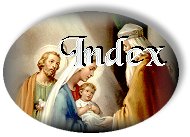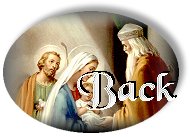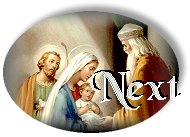****
CONGREGATION FOR CATHOLIC EDUCATION
RATIO FUNDAMENTALIS INSTITUTIONIS
DIACONORUM PERMANENTIUM
BASIC NORMS FOR THE FORMATION
OF PERMANENT DEACONS
INTRODUCTION
1. The paths
of formation
-
1. The first indications about the formation of permanent
deacons were given by the Apostolic Letter Sacrum diaconatus ordinem.(1)
These indications were then taken up and further refined
in the Circular Letter of the Sacred Congregation for Catholic Education
of 16 July 1969, Come è a conoscenza, in which were foreseen "different
types of formation" according to the "different types of diaconate" (for
celibates, married people, "those destined for mission territories or for
countries which were still developing", those called "to carry out their
function in countries with a certain level of civilization and a fairly
developed culture"). Regarding doctrinal formation, it was specified that
it must be above that required for a simple catechist and, in some way,
analogous to that of the priest. The material which had to be taken into
consideration when drawing up the programme of studies was then listed.(2)
The subsequent Apostolic Letter Ad pascendum specified
that "in regard to the course of theological studies that are to precede
the ordination of permanent deacons, the Episcopal Conferences, according
to the local situation, are competent to issue the appropriate norms and
submit them to the Sacred Congregation for Catholic Education for approval".(3)
The new Code of Canon Law brought together the essential
elements of this norm into canon 236.
-
2. After about thirty years from the first directives,
and with the contribution of subsequent experiences, it has been thought
opportune now to draw up the present Ratio fundamentalis institutionis
diaconorum permanentium. Its purpose is that of providing an instrument
for guiding and harmonizing, while respecting legitimate diversity, the
educational projects drawn up by the Episcopal Conferences and dioceses,
which at times vary greatly from one to another.
2. Reference
to a sure theology of the diaconate
-
3. The effectiveness of the formation of permanent deacons
depends to a great extent on the theological understanding of the diaconate
that underlies it. In fact it offers the co-ordinates for establishing
and guiding the formation process and, at the same time, lays down the
end to be attained. The almost total disappearance of the permanent diaconate
from the Church of the West for more than a millennium has certainly made
it more difficult to understand the profound reality of this ministry.
However, it cannot be said for that reason that the theology of the diaconate
has no authoritative points of reference, completely at the mercy of different
theological opinions. There are points of reference, and they are very
clear, even if they need to be developed and deepened. Some of the most
important of these will now follow, without, however, any claim to completeness.
-
4. First of all we must consider the diaconate, like every
other Christian identity, from within the Church which is understood as
a mystery of Trinitarian communion in missionary tension. This is a necessary,
even if not the first, reference in the definition of the identity of every
ordained minister insofar as its full truth consists in being a specific
participation in and representation of the ministry of Christ.(4) This
is why the deacon receives the laying on of hands and is sustained by a
specific sacramental grace which inserts him into the sacrament of Orders.(5)
-
5. The diaconate is conferred through a special outpouring
of the Spirit (ordination), which brings about in the one who receives
it a specific conformation to Christ, Lord and servant of all. Quoting
a text of the Constitutiones Ecclesiae Aegypticae, Lumen gentium (n. 29)
defines the laying on of hands on the deacon as being not "ad sacerdotium
sed ad ministerium",(6) that is, not for the celebration of the eucharist,
but for service. This indication, together with the admonition of Saint
Polycarp, also taken up again by Lumen gentium, n. 29,(7) outlines the
specific theological identity of the deacon: as a participation in the
one ecclesiastical ministry, he is a specific sacramental sign, in the
Church, of Christ the servant. His role is to "express the needs and desires
of the Christian communities" and to be "a driving force for service, or
diakonia",(8) which is an essential part of the mission of the Church.
-
6. The matter of diaconal ordination is the laying on
of the hands of the Bishop; the form is constituted by the words of the
prayer of ordination, which is expressed in the three moments of anamnesis,
epiclesis and intercession.(9) The anamnesis (which recounts the history
of salvation centered in Christ) goes back to the "levites", recalling
worship, and to the "seven" of the Acts of the Apostles, recalling charity.
The epiclesis invokes the power of the seven gifts of the Spirit so that
the ordinand may imitate Christ as "deacon". The intercession is an exhortation
to a generous and chaste life.
The essential form of the sacrament is the epiclesis,
which consists of the words: "Lord, send forth upon them the Holy Spirit,
that they may be strengthened by the gift of your sevenfold grace to carry
out faithfully the work of the ministry". The seven gifts originate in
a passage of Isaiah 11:2, from the fuller version given by the Septuagint.
These are the gifts of the Spirit given to the Messiah, which are granted
to the newly ordained.
-
7. Insofar as it is a grade of holy orders, the diaconate
imprints a character and communicates a specific sacramental grace. The
diaconal character is the configurative and distinguishing sign indelibly
impressed in the soul, which configures the one ordained to Christ, who
made himself the deacon or servant of all.(10) It brings with it a specific
sacramental grace, which is strength, vigor specialis, a gift for living
the new reality wrought by the sacrament. "With regard to deacons, 'strengthened
by sacramental grace they are dedicated to the People of God, in conjunction
with the bishop and his body of priests, in the service (diakonia) of the
liturgy, of the Gospel and of works of charity'".(11) Just as in all sacraments
which imprint character, grace has a permanent virtuality. It flowers again
and again in the same measure in which it is received and accepted again
and again in faith.
-
8. In the exercise of their power, deacons, since they
share in a lower grade of ecclesiastical ministry, necessarily depend on
the Bishops, who have the fullness of the sacrament of orders. In addition,
they are placed in a special relationship with the priests, in communion
with whom they are called to serve the People of God.(12)
From the point of view of discipline, with diaconal
ordination, the deacon is incardinated into a particular Church or personal
prelature to whose service he has been admitted, or else, as a cleric,
into a religious institute of consecrated life or a clerical society of
apostolic life.(13) Incardination does not represent something which is
more or less accidental, but is characteristically a constant bond of service
to a concrete portion of the People of God. This entails ecclesial membership
at the juridical, affective and spiritual level and the obligation of ministerial
service.
3. The
ministry of the deacon in different pastoral contexts
-
9. The ministry of the deacon is characterized by the
exercise of the three munera proper to the ordained ministry, according
to the specific perspective of diakonia.
In reference to the munus docendi the deacon is called
to proclaim the Scriptures and instruct and exhort the people.(14) This
finds expression in the presentation of the Book of the Gospels, foreseen
in the rite of ordination itself.(15)
The munus sanctificandi of the deacon is expressed
in prayer, in the solemn administration of baptism, in the custody and
distribution of the Eucharist, in assisting at and blessing marriages,
in presiding at the rites of funeral and burial and in the administration
of sacramentals.(16) This brings out how the diaconal ministry has its
point of departure and arrival in the Eucharist, and cannot be reduced
to simple social service.
Finally, the munus regendi is exercised in dedication
to works of charity and assistance (17) and in the direction of communities
or sectors of church life, especially as regards charitable activities.
This is the ministry most characteristic of the deacon.
-
10. As can be seen from original diaconal practice and
from conciliar indications, the outlines of the ministerial service inherent
in the diaconate are very well defined. However, even if this inherent
ministerial service is one and the same in every case, nevertheless the
concrete ways of carrying it out are diverse; these must be suggested,
in each case, by the different pastoral situations of the single Churches.
In preparing the formation to be imparted, these should obviously be taken
into account.
4. Diaconal spirituality
-
11. The outlines of the specific spirituality of the deacon
flow clearly from his theological identity; this spirituality is one of
service.
The model "par excellence" is Christ the servant,
who lived totally at the service of God, for the good of men. He recognized
himself as the one announced in the servant of the first song of the Book
of Isaiah (cf Lk 4:18-19), he explicitly qualified his action as diakonia
(cf Mt 20:28; Lk 22:27; Jn 13:1-17; Phil 2:7-8; 1 Pet 2:21-25) and he entrusted
his disciples to do the same (cf Jn 13:34-35; Lk 12:37).
The spirituality of service is a spirituality of the
whole Church, insofar as the whole Church, in the same way as Mary, is
the "handmaid of the Lord" (Lk 1:28), at the service of the salvation of
the world. And so that the whole Church may better live out this spirituality
of service, the Lord gives her a living and personal sign of his very being
as servant. In a specific way, this is the spirituality of the deacon.
In fact, with sacred ordination, he is constituted a living icon of Christ
the servant within the Church. The Leitmotiv of his spiritual life will
therefore be service; his sanctification will consist in making himself
a generous and faithful servant of God and men, especially the poorest
and most suffering; his ascetic commitment will be directed towards acquiring
those virtues necessary for the exercise of his ministry.
-
12. Obviously such a spirituality must integrate itself
harmoniously, in each case, with the spirituality related to the state
of life. Accordingly, the same diaconal spirituality acquires diverse connotations
according to whether it be lived by a married man, a widower, a single
man, a religious, a consecrated person in the world. Formation must take
account of these variations and offer differentiated spiritual paths according
to the types of candidates.
5. The
role of Episcopal Conferences
-
13. "It is the competence of legitimate assemblies of
Bishops or Episcopal Conferences to decide, with the consent of the Supreme
Pontiff, whether and where the diaconate is to be established as a permanent
rank in the hierarchy for the good of souls".(18)
The Code of Canon Law likewise attributes to the Episcopal
Conferences the competence to specify, by means of complementary dispositions,
the discipline regarding the recitation of the liturgy of the hours,(19)
the required age for admission (20) and the formation given; can. 236 is
dedicated to this. The canon lays down that it is the Episcopal Conferences,
on the basis of local circumstances, which issue the appropriate norms
to ensure that candidates for the permanent diaconate, whether young or
of a more mature age, whether single or married are "...formed in the spiritual
life and appropriately instructed in the fulfillment of the duties proper
to that order...".
-
14. To assist the Episcopal Conferences in preparing a
formation which, as well as being attentive to diverse particular situations,
will still be in harmony with the universal direction of the Church, the
Congregation for Catholic Education has prepared the present Ratio fundamentalis
institutionis diaconorum permanentium, which is intended as a point of
reference for defining the criteria of vocational discernment and the various
aspects of formation. This document—by its very nature—establishes only
some basic guidelines of a general character, which constitute the norm
to which the Episcopal Conferences must make reference for the preparation
or eventual perfecting of their respective national rationes. In this way
the principles and criteria on the basis of which the formation of permanent
deacons can be programmed with surety and in harmony with the other Churches
shall be illustrated, without stifling the creativity or originality of
the particular Churches.
-
15. In the same way that the Second Vatican Council established
for the rationes institutionis sacerdotalis,(21) with this document, the
Episcopal Conferences which have restored the permanent diaconate are requested
to submit their respective rationes institutionis diaconorum permanentium
for examination and approval by the Holy See. The same will approve them,
firstly, ad experimentum, and, then for a specified number of years, so
as to guarantee periodic revisions.
6. Responsibility
of Bishops
-
16. The restoration of the permanent diaconate in a nation
does not imply the obligation of restoring it in all its dioceses. The
diocesan Bishop will proceed or not in this regard, after having prudently
heard the recommendation of the Council of Priests and, if it exists, the
Pastoral Council, and taking account of concrete needs and the specific
situation of his particular Church.
If he opts for the restoration of the permanent diaconate,
he will take care to promote a suitable catechesis on the subject, both
among laity and priests and religious, in such a way that the diaconal
ministry may be fully understood. In addition, he will provide for the
setting up of the structures necessary for the work of formation and for
nominating suitable associates to assist him by being directly responsible
for formation, or, according to circumstances, he will commit himself to
employing the formation structures of other dioceses, or those of the region
or nation.
The Bishop will then take care that, on the basis
of the national ratio and actual experience, an appropriate rule be drafted
and periodically revised.
7. The
permanent diaconate in institutes of consecrated life and in societies
of apostolic life
-
17. The institution of the permanent diaconate among the
members of institutes of consecrated life and societies of apostolic life
is regulated by the norms of the Apostolic Letter Sacrum diaconatus ordinem.
It establishes that "Institution of the permanent diaconate among religious
is a right reserved to the Holy See, which alone is competent to examine
and approve the votes of general chapters in the matter".(22) The document
continues: "Whatever is said...is to be understood as applying to the members
of other institutes professing the evangelical counsels".(23)
Each institute or society which has obtained the right
to re-establish the permanent diaconate assumes the responsibility of guaranteeing
the human, spiritual, intellectual and pastoral formation of its candidates.
Such an institute or society must commit itself therefore to preparing
its own formation programme which incorporates the specific charism and
spirituality of the institute or society and, at the same time, is in harmony
with the present Ratio fundamentalis, especially as regards intellectual
and pastoral formation.
The programme of each institute or society should
be submitted for examination and approval to the Congregation for Institutes
of Consecrated Life and Societies of Apostolic Life or the Congregation
for the Evangelization of Peoples and the Congregation for the Oriental
Churches for territories where they are competent. The competent Congregation,
having obtained the opinion of the Congregation for Catholic Education
as regards intellectual formation, will approve it, firstly ad experimentum,
and then for a specific number of years, so as to guarantee periodic revisions.




